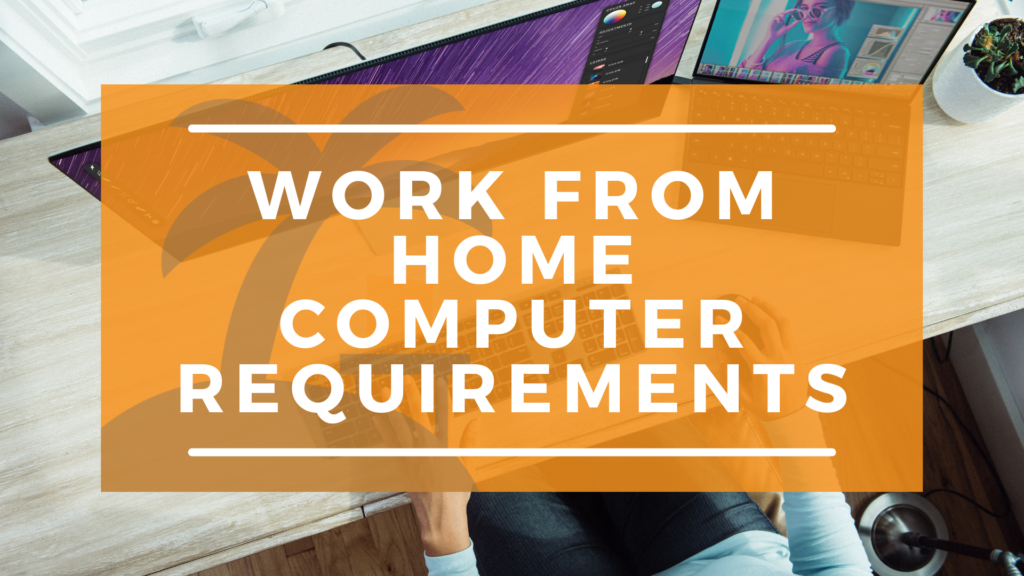Computer Requirements To Work From Home

Imagine sipping your morning coffee, sunlight streaming through your window, as you settle into your home office. No commute, no crowded office space, just the gentle hum of your computer as you prepare to tackle the day. But before you dive into spreadsheets and video calls, it's crucial to ensure your tech is up to the task of this new normal.
The shift to remote work has redefined the modern workplace, placing a greater emphasis on robust and reliable home computer setups. Understanding the essential computer requirements for working from home is no longer a luxury, but a necessity for productivity, security, and overall job satisfaction.
The Foundation: Operating System and Processor
At the heart of any functional computer is its operating system. Windows 10 or 11 and macOS are the most common choices, offering compatibility with a wide range of software and applications.
Ensure your operating system is up to date to receive the latest security patches and performance improvements. An outdated OS can leave you vulnerable to cyber threats, a serious concern when handling sensitive company data from home.
The processor, or CPU, is the brains of your computer. For most work-from-home tasks like word processing, email, and web browsing, an Intel Core i5 or an AMD Ryzen 5 processor should suffice.
Memory (RAM) and Storage
Random Access Memory, or RAM, is crucial for multitasking. Aim for at least 8GB of RAM to smoothly run multiple applications simultaneously.
If you frequently work with large files or demanding software, 16GB is highly recommended. Insufficient RAM can lead to frustrating lags and slowdowns.
For storage, consider a Solid State Drive (SSD). SSDs offer significantly faster boot times and application loading compared to traditional Hard Disk Drives (HDDs).
A 256GB SSD is a good starting point, but a 512GB or 1TB drive provides more breathing room for your files and programs. Cloud storage solutions like Google Drive or Microsoft OneDrive can also supplement your local storage.
Display and Peripherals
Your monitor is your window to the digital world. A monitor of at least 24 inches is recommended for comfortable viewing and productivity.
Consider a second monitor to expand your workspace and improve multitasking efficiency. A good quality keyboard and mouse are also essential for comfortable and efficient typing and navigation.
Don't underestimate the importance of a reliable webcam and headset. These are your lifelines for video conferencing and online meetings.
Choose a webcam with good resolution and a headset with clear audio to ensure you're seen and heard clearly during virtual interactions.
Connectivity and Security
A stable and fast internet connection is non-negotiable for remote work. Aim for a minimum download speed of 25 Mbps and an upload speed of 5 Mbps.
A wired Ethernet connection is generally more reliable than Wi-Fi. Invest in a good quality router that supports the latest Wi-Fi standards.
Security is paramount when working from home. Install a reputable antivirus software and keep it updated.
Enable a firewall and use strong, unique passwords for all your accounts. Consider using a VPN (Virtual Private Network) to encrypt your internet traffic and protect your data.
Beyond the Basics: Ergonomics and Environment
While the technical specifications are important, don't forget about ergonomics. Invest in a comfortable chair, a supportive keyboard wrist rest, and ensure your monitor is at eye level.
A well-lit and organized workspace can significantly improve your focus and productivity. Take regular breaks to stretch and move around to avoid physical strain.
According to a study by Stanford University, a well-designed home office can increase productivity by as much as 22%. Creating a dedicated workspace helps separate your work life from your personal life, promoting a healthier work-life balance.
Looking Ahead
As technology evolves, so will the requirements for remote work. Staying informed about the latest trends and best practices is crucial for maintaining a productive and secure work-from-home environment.
Regularly assess your computer setup and upgrade components as needed. Consider consulting with an IT professional to ensure your system meets the specific requirements of your job.
Ultimately, a well-equipped and optimized home office empowers you to work efficiently and effectively, regardless of location. Embrace the flexibility and convenience of remote work, knowing that your technology is supporting you every step of the way.

















